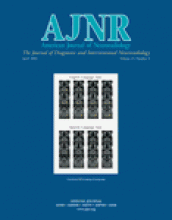Abstract
BACKGROUND AND PURPOSE: Blood flow of the internal jugular vein and intracranial venous sinuses is affected by respiratory state. The purpose of this study was to clarify the changes in flow velocity and direction and signal intensities of sigmoid sinuses on phase-contrast (PC) MR images obtained with regular breathing and with deep inspiratory breath holding.
METHODS: One hundred seven subjects without venous sinus abnormality were studied. Coronal 2D PC MR venography and axial 2D PC images with peripheral pulse gating were acquired with a 1.5-T MR unit, during regular breathing and deep inspiratory breath holding. The signal intensity changes of bilateral sigmoid sinuses on MR venograms and the changes of flow velocity and direction on the axial 2D PC images were analyzed.
RESULTS: Breath holding decreased signal intensities of the right and left sigmoid sinuses on MR venograms in 57 (53.3%) and 36 (33.6%) subjects, respectively. Increased signal intensity was observed in 12 (11.2%) and 33 (30.8%) subjects, respectively. In the flow analysis, retrograde flow was detected at the left sigmoid sinus in four subjects (3.7%) during regular breathing, which was normalized by breath holding. Flow velocities of the right and left sigmoid sinuses decreased during breath holding in 92 (86.0%) and 70 (65.4%) subjects, and increased in 15 (14.0%) and 37 (34.6%) subjects, respectively.
CONCLUSION: The signal intensities of sigmoid sinuses were affected by breath holding in about 2/3 of the subjects. Breath-holding maneuver can be used to increase blood flow and signal intensities of dural venous sinuses on PC MR venograms.
- Copyright © American Society of Neuroradiology












